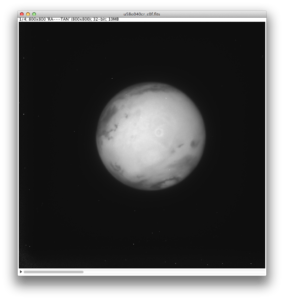The HST planetary data service is an excerpt from the complete Hubble Space Telescope archive limited to observations of planets, dwarf planets, and satellites. Data description is based on the Canadian Astronomy Data Centre (CADC) archive in Victoria, BC, and data files are linked to the CADC archive.
The CADC web site includes a search interface providing access to the complete archive plus extensive documentation: http://www.cadc-ccda.hia-iha.nrc-cnrc.gc.ca
Virtual Observatory service
A Virtual Observatory (VO) data service has been set up to provide easier access to Hubble Space Telescope (HST) observations of the main objects in the Solar System.
– Only dedicated observations of planets, dwarf planets, and satellites are included in this service (no comets or asteroids), and only calibrated and derived files are provided (no raw data). Several levels of processing are generally available, and the most adequate one is selected for each instrument. Data from the Hubble Legacy Archive (HSTHLA) are not currently included.
– Targets are explicitely identified, and are more easily retrieved than from the original HST catalogue.
– The service is updated daily to include new observations. However, the most recent ones may be under embargo and therefore not directly accessible, although descriptions are available.
– Thumbnails are provided when available, and are selected from those distributed at CADC. Thumbnails may be missing, in particular during proprietary periods (i.e. when parameter release_date is in the future). Thumbnails of images may show only a part of the FoV, which not always include the main target.
The data are presented in a table with descriptive parameters for each file, extracted from the CADC catalogue and fits headers:
– Data description complies with the EPN-TAP protocol, with addition of extra parameters to accommodate the original descriptions.
– A link to physical ephemeris provides additional information.
– Each line of the table includes a link to the original data file in the CADC archive (fits format). Access may be restrained during proprietary period.
This data service can be queried from the VESPA portal of Solar System data: http://vespa.obspm.fr/
See the complete data service in VESPA (schema name is hst_planeto).
Tutorials about images and spectra in the Planetary Science VO context are available here: http://www.europlanet-vespa.eu/tutos.shtml
In short: you first identify data of interest from a search interface, then send selected results in a visualization and analysis tool. The plotting tools of choice are Aladin for images (but ds9 and ImageJ may also be convenient) and CASSIS (or SPLAT-VO) for spectra.

Fig.1: A calibrated WFPC2 image of Mars from 1999 displayed in ImageJ
Looking for images and spectra
The service uses the TAP protocol with parameters optimized for Planetary Science data (EPN-TAP). Since all TAP parameters are searchable, this protocol is more adapted to moving targets than the SIAP or Cone Search protocols available on most HST archives, which are based on sky coordinates.
Searches can be performed from the VESPA portal, which queries this service together with many others and provides an optimized interface, e. g., by performing unit conversions. Other TAP interfaces (TAPhandle, TOPCAT, etc) are also functional.
Query results are tables, with one line describing each match. The access_url column provides a link to the original data file in the CADC archive.
The main search parameters are:
target_name – Only the main target is listed (e. g., satellites may be present but not mentioned). To help identify secondary targets, the parameters proposal_target_name, target_description and proposal_title provide additional information extracted from the original HST catalogue – they are intended as descriptive parameters rather than search keys.
target_class – can be either planet, satellite, or dwarf planet. The object 2007 OR10, best candidate for the status of new dwarf planet, is also included with target_class = asteroid.
instrument_name – provides the intrument name alone (without detector name).
detector_name and obs_mode – provide the instrument detector and the observing mode in use.
time_min and time_max – these parameters provide the time of start and stop of acquision in Julian Days (the VESPA portal converts this to standard ISO dates).
granule_gid – distinguishes between calibrated and derived product (same as processing_level = 2 or 3).
file_name – is uniform among the various HST archives. This may be used to retrieve a file from another archive portal, possibly with a different processing. File nomenclature is detailed here: http://www.cadc-ccda.hia-iha.nrc-cnrc.gc.ca/en/hst/filenames.html
Spectral information is provided through several parameters:
spectral_range_min and spectral_range_max – provide the spectral range on a frequency scale in Hz (the VESPA portal can display this in micron). For use with other interfaces, spectral range conversion from Hz to µm goes like this:
– min_wvl = 2.99792458E14 / max_freq
– max_wvl = 2.99792458E14 / min_freq
filter – standard name of the filter in use, if any. Filter characteristics can be accessed via the following VO service: http://svo2.cab.inta-csic.es/svo/theory/fps3
waveband – overall spectral band in use, as per VO standards.
Data origin can be traced using the proposal_pi, proposal_title, and proposal_id parameters. Related publications can be searched in ADS or in the ESA HST archive.
For instance, an ADQL query for images of Mars in 2003 writes:
SELECT * FROM hst_planeto.epn_core where dataproduct_type = ‘im’
AND target_name= ‘Mars’
AND time_max <= 2453004.50000000 AND time_min >= 2452640.50000000
— This is more easily entered in the VESPA portal.
Extra geometry information
The data table contains the observing parameters retrieved from the original archive, presented according to the EPN-TAP standard. In particular the C1/C2 parameters provides celestical coordinates of the target (RA / Dec in degrees) and s_region provides a footprint. The phase angle parameter of the table however is empty.
Extra information is available under the parameter datalink_url for each observation. This parameter links a physical ephemeris for this observation which provides quantities such as phase angle, coordinates of disk center and sub-solar point, disk orientation and apparent size, distances, V magnitude, etc… as seen from HST at the time of acquisition. These quantities are computed in real time by the Miriade ephemeris system at IMCCE/Observatoire de Paris (using the Spice kernel for HST produced by JPL), and are not searchable. This may require several seconds if the server is busy.
A simulation image of the configuration observed is also provided with subsolar point in yellow, disk center in red, prime meridian in cyan, and nightside greyed. This representation relies on a triaxial ellipsoid representation of the target.
– From an interactive interface such as the VESPA portal, clicking datalink_url opens a window providing three new links: the html one is human-readable and will display in your browser; the VOtable one can be sent to a VO tool or stored for detailed data processing; the third link will display the image in your browser.
– From TOPCAT (> v.4.6), links can be activated on demand (Menu View>Activation actions, then “View Datalink Table”). The html table can be sent for display in a browser, the VOtable can be loaded in TOPCAT itself, while the simulation image can be displayed internally in TOPCAT or sent to your browser.
Coordinates are provided in planetocentric system with longitudes increasing eastward.
Global information about the object (such as radii, rotational elements, taxonomic and dynamical types, etc) is available in the VOtable header, or can be displayed under the light bulb icon in the html version.
Ephemeris information may be unavailable in some cases, in particular for the most recent data (if the HST trajectory is not yet ingested in the computing system) and for some satellites (if the shape is unknown or the motion not solved).
Displaying images and spectra in VO tools
Several VO tools can open and display the HST data, in particular when sent through the SAMP protocol from the VESPA search portal (click to select row + “Data selection” menu at bottom of the result page):
• CASSIS accepts files passed as spectra only
• SPLAT-VO accepts files passed either as spectra or tables
• Aladin accepts files passed as images (fits only)
• ImageJ accepts files passed as images when used with the SAMP plug-in from PADC
• TOPCAT accepts files passed as tables only (use with the “Metadata selection” menu)
• Both TOPCAT and Aladin can plot the footprints provided in the s_region parameter
However, all combinations of files and VO tools are not currently effective, due to specific variations in the fits formatting used by HST.
Both CASSIS and SPLAT-VO check the spectral quantity of input spectra. A warning is issued in CASSIS when overplotting different quantities, but this does not prevent from plotting the spectra (manual scaling is required in this case). CASSIS can handle 2D spectra by either adding or averaging consecutive spectra.
Other services distributing HST data
HST data of the Solar System are distributed on several other sites and data services:
• The CADC portal distributes all HST and HSTHLA data, and mirrors the archives of various telescopes (based in North America). Specific services include a Solar System Objects Image Search relying on several ephemeris servers, and a VO interface via the regular TAP protocol: http://www.cadc-ccda.hia-iha.nrc-cnrc.gc.ca/
• ESA’s HST portal provides a different search interface (based in Europe). Specific additions include the precomputation of geometric configurations to identify Solar System objects visible in the fields of view, and reference of publications: http://archives.esac.esa.int/ehst/
• The MAST / STScI portal provides access to HST and other orbiting telescope archives (based in North America). Includes a VO interface via SIAP and Cone Search (adapted to still objects): http://archive.stsci.edu/
• The APIS service (Lamy et al., A&C, 2015) mostly contains a selection of HST data: http://lesia.obspm.fr/apis/
In addition to the web site access, this service also has VO access using the EPN-TAP protocol, and is also searchable through the VESPA portal. The scope is different, as this service focuses on auroral phenomena on the giant planets. Data mainly consist in dynamic (2D) spectra in the far-UV range, and in projected images. The service includes specific derived products and non-HST data.
• The OPUS project from the PDS ring-moon systems node provides interactive access to HST data related to satellites and rings, together with data from space missions:
https://tools.pds-rings.seti.org/opus/#/missionid=Hubble
• The PDS geosciences node distributes a dataset of derived products for the 1999-2001 oppositions of Mars (fits files with detached PDS labels, in both cylindrical and orthographic projections, available as separated images and spectral cubes with viewing angles):
http://pds-geosciences.wustl.edu/missions/earthbased/hst_cornell.htm
Contact the helpdesk for comments: support.vespa@obspm.fr
_____________________
This data service is provided in the framework of the VESPA activity in Europlanet-2020 and Europlanet-2024 by Paris Astronomical Data Centre (PADC).
The Europlanet 2020 Research Infrastructure project has received funding from the European Union’s Horizon 2020 research and innovation programme under grant agreement No 654208. Additional funding was provided in France by the Action Spécifique Observatoire Virtuel and Programme National de Planétologie / INSU.


